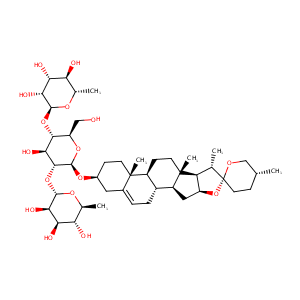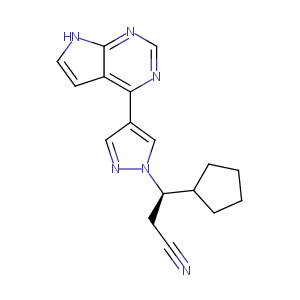| DOT Name |
DOT ID |
UniProt ID |
Mode of Action |
REF |
|
Tumor necrosis factor receptor superfamily member 10B (TNFRSF10B)
|
OTA1CPBV
|
TR10B_HUMAN
|
Increases Expression
|
[9] |
|
Baculoviral IAP repeat-containing protein 5 (BIRC5)
|
OTILXZYL
|
BIRC5_HUMAN
|
Increases Expression
|
[9] |
|
Serine/threonine-protein kinase Chk2 (CHEK2)
|
OT8ZPCNS
|
CHK2_HUMAN
|
Decreases Expression
|
[9] |
|
Cyclin-dependent kinase 1 (CDK1)
|
OTW1SC2N
|
CDK1_HUMAN
|
Decreases Expression
|
[9] |
|
Apoptosis regulator Bcl-2 (BCL2)
|
OT9DVHC0
|
BCL2_HUMAN
|
Decreases Expression
|
[9] |
|
Cytochrome P450 2C9 (CYP2C9)
|
OTGLBN29
|
CP2C9_HUMAN
|
Increases Expression
|
[9] |
|
G2/mitotic-specific cyclin-B1 (CCNB1)
|
OT19S7E5
|
CCNB1_HUMAN
|
Decreases Expression
|
[9] |
|
Ribosomal protein S6 kinase beta-1 (RPS6KB1)
|
OTAELNGX
|
KS6B1_HUMAN
|
Decreases Expression
|
[9] |
|
RAC-alpha serine/threonine-protein kinase (AKT1)
|
OT8H2YY7
|
AKT1_HUMAN
|
Decreases Expression
|
[9] |
|
Cyclin-dependent kinase inhibitor 1 (CDKN1A)
|
OTQWHCZE
|
CDN1A_HUMAN
|
Increases Expression
|
[9] |
|
Phosphatidylinositol 4,5-bisphosphate 3-kinase catalytic subunit beta isoform (PIK3CB)
|
OTO8JQJA
|
PK3CB_HUMAN
|
Decreases Expression
|
[9] |
|
Serine/threonine-protein kinase mTOR (MTOR)
|
OTHH8KU7
|
MTOR_HUMAN
|
Decreases Expression
|
[9] |
|
Mitogen-activated protein kinase 8 (MAPK8)
|
OTEREYS5
|
MK08_HUMAN
|
Increases Expression
|
[9] |
|
Mitogen-activated protein kinase 9 (MAPK9)
|
OTCEVJ9E
|
MK09_HUMAN
|
Increases Expression
|
[9] |
|
Caspase-7 (CASP7)
|
OTAPJ040
|
CASP7_HUMAN
|
Increases Expression
|
[9] |
|
Tumor necrosis factor receptor type 1-associated DEATH domain protein (TRADD)
|
OTBOSJHO
|
TRADD_HUMAN
|
Increases Expression
|
[9] |
|
Caspase-10 (CASP10)
|
OTE6J88E
|
CASPA_HUMAN
|
Increases Expression
|
[9] |
|
Tumor necrosis factor receptor superfamily member 25 (TNFRSF25)
|
OTVZ7I3A
|
TNR25_HUMAN
|
Increases Expression
|
[9] |
|
Bcl-2-binding component 3, isoforms 3/4 (BBC3)
|
OTUAXDAY
|
BBC3B_HUMAN
|
Increases Expression
|
[9] |
|
Diablo IAP-binding mitochondrial protein (DIABLO)
|
OTHJ9MCZ
|
DBLOH_HUMAN
|
Increases Expression
|
[9] |
|
5'-AMP-activated protein kinase subunit beta-1 (PRKAB1)
|
OT1OG4QZ
|
AAKB1_HUMAN
|
Increases Expression
|
[9] |
|
Apoptotic protease-activating factor 1 (APAF1)
|
OTJWIVY0
|
APAF_HUMAN
|
Decreases Expression
|
[11] |
|
Serine/threonine-protein kinase Chk1 (CHEK1)
|
OTTTI622
|
CHK1_HUMAN
|
Decreases Expression
|
[11] |
|
Tumor necrosis factor (TNF)
|
OT4IE164
|
TNFA_HUMAN
|
Increases Expression
|
[12] |
|
Estrogen receptor (ESR1)
|
OTKLU61J
|
ESR1_HUMAN
|
Increases Expression
|
[13] |
|
Cellular tumor antigen p53 (TP53)
|
OTIE1VH3
|
P53_HUMAN
|
Increases Expression
|
[12] |
|
ATP-dependent translocase ABCB1 (ABCB1)
|
OTEJROBO
|
MDR1_HUMAN
|
Decreases Expression
|
[14] |
|
Poly polymerase 1 (PARP1)
|
OT310QSG
|
PARP1_HUMAN
|
Decreases Expression
|
[11] |
|
Cyclin-dependent kinase 4 (CDK4)
|
OT7EP05T
|
CDK4_HUMAN
|
Decreases Expression
|
[11] |
|
Tumor necrosis factor receptor superfamily member 1A (TNFRSF1A)
|
OT2D9DOV
|
TNR1A_HUMAN
|
Increases Expression
|
[12] |
|
Cyclin-A2 (CCNA2)
|
OTPHHYZJ
|
CCNA2_HUMAN
|
Decreases Expression
|
[11] |
|
G1/S-specific cyclin-D1 (CCND1)
|
OT8HPTKJ
|
CCND1_HUMAN
|
Decreases Expression
|
[11] |
|
G1/S-specific cyclin-E1 (CCNE1)
|
OTLD7UID
|
CCNE1_HUMAN
|
Decreases Expression
|
[11] |
|
Cyclin-dependent kinase 2 (CDK2)
|
OTB5DYYZ
|
CDK2_HUMAN
|
Decreases Expression
|
[11] |
|
Tumor necrosis factor receptor superfamily member 6 (FAS)
|
OTP9XG86
|
TNR6_HUMAN
|
Increases Expression
|
[12] |
|
NF-kappa-B inhibitor alpha (NFKBIA)
|
OTFT924M
|
IKBA_HUMAN
|
Decreases Degradation
|
[14] |
|
Catenin beta-1 (CTNNB1)
|
OTZ932A3
|
CTNB1_HUMAN
|
Increases Expression
|
[13] |
|
Caspase-3 (CASP3)
|
OTIJRBE7
|
CASP3_HUMAN
|
Decreases Expression
|
[11] |
|
Cyclin-dependent kinase inhibitor 2A (CDKN2A)
|
OTN0ZWAE
|
CDN2A_HUMAN
|
Increases Expression
|
[11] |
|
Cyclin-dependent kinase inhibitor 1B (CDKN1B)
|
OTNY5LLZ
|
CDN1B_HUMAN
|
Increases Expression
|
[11] |
|
Tumor necrosis factor ligand superfamily member 6 (FASLG)
|
OTZARCHH
|
TNFL6_HUMAN
|
Increases Expression
|
[12] |
|
Caspase-9 (CASP9)
|
OTD4RFFG
|
CASP9_HUMAN
|
Decreases Expression
|
[11] |
|
BH3-interacting domain death agonist (BID)
|
OTOSHSHU
|
BID_HUMAN
|
Decreases Expression
|
[12] |
|
Cytochrome c (CYCS)
|
OTBFALJD
|
CYC_HUMAN
|
Increases Expression
|
[11] |
|
Cyclin-dependent kinase 6 (CDK6)
|
OTR95N0X
|
CDK6_HUMAN
|
Decreases Expression
|
[11] |
|
Apoptosis regulator BAX (BAX)
|
OTAW0V4V
|
BAX_HUMAN
|
Increases Expression
|
[11] |
|
Bcl-2-like protein 1 (BCL2L1)
|
OTRC5K9O
|
B2CL1_HUMAN
|
Decreases Expression
|
[12] |
|
Forkhead box protein O1 (FOXO1)
|
OTPJRB6D
|
FOXO1_HUMAN
|
Increases Expression
|
[11] |
|
TNF receptor-associated factor 1 (TRAF1)
|
OTTLM5RU
|
TRAF1_HUMAN
|
Increases Expression
|
[12] |
|
FAS-associated death domain protein (FADD)
|
OTV7GFHH
|
FADD_HUMAN
|
Increases Expression
|
[12] |
|
Caspase-8 (CASP8)
|
OTA8TVI8
|
CASP8_HUMAN
|
Decreases Expression
|
[11] |
|
Bcl-2 homologous antagonist/killer (BAK1)
|
OTDP6ILW
|
BAK_HUMAN
|
Increases Expression
|
[12] |
|
Estrogen receptor beta (ESR2)
|
OTXNR2WQ
|
ESR2_HUMAN
|
Increases Expression
|
[13] |
|
Bcl2-associated agonist of cell death (BAD)
|
OT63ERYM
|
BAD_HUMAN
|
Increases Expression
|
[11] |
| ------------------------------------------------------------------------------------ |
|
|
|
|


